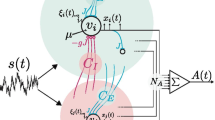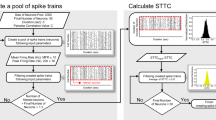Abstract
This study investigates the ability of a diverging/converging neural network to transmit and integrate a complex temporally organized activity embedded in afferent spike trains. The temporal information is originally generated by a deterministic nonlinear dynamical system whose parameters determine a chaotic attractor. We present the simulations obtained with a network formed by simple spiking neurons (SSN) and a network formed by a multiple-timescale adaptive threshold neurons (MAT). The assessment of the temporal structure embedded in the spike trains is carried out by sorting the preferred firing sequences detected by the pattern grouping algorithm (PGA). The results suggest that adaptive threshold neurons are much more efficient in maintaining a specific temporal structure distributed across multiple spike trains throughout the layers of a feed-forward network.
Access this chapter
Tax calculation will be finalised at checkout
Purchases are for personal use only
Preview
Unable to display preview. Download preview PDF.
Similar content being viewed by others
References
Mpitsos, G.J.: Chaos in brain function and the problem of nonstationarity: a commentary. In: Basar, E., Bullock, T.H. (eds.) Dynamics of Sensory and Cognitive Processing by the Brain, pp. 521–535. Springer, Heidelberg (1989)
Celletti, A., Villa, A.E.P.: Determination of chaotic attractors in the rat brain. J. Stat. Physics 84, 1379–1385 (1996)
Tetko, I.V., Villa, A.E.: A comparative study of pattern detection algorithm and dynamical system approach using simulated spike trains. In: Gerstner, W., Hasler, M., Germond, A., Nicoud, J.-D. (eds.) ICANN 1997. LNCS, vol. 1327, pp. 37–42. Springer, Heidelberg (1997)
Asai, Y., Yokoi, T., Villa, A.E.P.: Detection of a dynamical system attractor from spike train analysis. In: Kollias, S.D., Stafylopatis, A., Duch, W., Oja, E. (eds.) ICANN 2006. LNCS, vol. 4131, pp. 623–631. Springer, Heidelberg (2006)
Asai, Y., Guha, A., Villa, A.E.P.: Deterministic neural dynamics transmitted through neural networks. Neural Networks 21, 799–809 (2008)
Abeles, M.: Local Cortical Circuits. Springer, Heidelberg (1982)
Asai, Y., Villa, A.E.: Spatio temporal filtering of the distributed spike train with deterministic structure by ensemble of spiking neurons. In: The 8th Intenational Neural Coding Workshop Proceedings, Tainan, Taiwan, pp. 81–83 (2009)
Izhikevich, E.M.: Which model to use for cortical spiking neurons? IEEE Transactions on Neural Networks 15, 1063–1070 (2004)
Kobayashi, R., Tsubo, Y., Shinomoto, S.: Made-to-order spiking neuron model equipped with a multi-timescale adaptive threshold. Front Comput. Neurosci. 3 (2009), doi:10.3389/neuro.10.009.2009
Brette, R., Gerstner, W.: Adaptive exponential integrate-and-fire model as an effective description of neuronal activity. J. Neurophysiol. 94, 3637–3642 (2005)
Zaslavskii, G.M.: The simplest case of a strange attractor. Phys. Let. 69A, 145–147 (1978)
Villa, A.E.P., Tetko, I.V.: Spatiotemporal activity patterns detected from single cell measurements from behaving animals. In: Proceedings SPIE, vol. 3728, pp. 20–34 (1999)
Tetko, I.V., Villa, A.E.P.: A pattern grouping algorithm for analysis of spatiotemporal patterns in neuronal spike trains. 1. detection of repeated patterns. J. Neurosci. Meth. 105, 1–14 (2001)
Abeles, M., Gat, I.: Detecting precise firing sequences in experimental data. Journal of Neuroscience Methods 107, 141–154 (2001)
Sacerdote, L., Villa, A.E., Zucca, C.: On the classification of experimental data modeled via a stochastic leaky integrate and fire model through boundary values. Bull. Math. Biol. 68, 1257–1274 (2006)
Author information
Authors and Affiliations
Editor information
Editors and Affiliations
Rights and permissions
Copyright information
© 2010 Springer-Verlag Berlin Heidelberg
About this paper
Cite this paper
Asai, Y., Villa, A.E.P. (2010). Transmission of Distributed Deterministic Temporal Information through a Diverging/Converging Three-Layers Neural Network. In: Diamantaras, K., Duch, W., Iliadis, L.S. (eds) Artificial Neural Networks – ICANN 2010. ICANN 2010. Lecture Notes in Computer Science, vol 6352. Springer, Berlin, Heidelberg. https://doi.org/10.1007/978-3-642-15819-3_19
Download citation
DOI: https://doi.org/10.1007/978-3-642-15819-3_19
Publisher Name: Springer, Berlin, Heidelberg
Print ISBN: 978-3-642-15818-6
Online ISBN: 978-3-642-15819-3
eBook Packages: Computer ScienceComputer Science (R0)




